Pancha Ganapati

Pancha Ganapati, which originated in 1985, is the five-day Winter Solstice celebration for Hindus and is observed from the 21st through 25th of December. During this time Hindus pray to Ganesha, the elephant-headed, five-faced, four-armed God. Pancha (five) refers to Ganesha’s five faces, each of which represents a particular type of shakti (power) representing a specific power. One face is worshiped on each of the five days. Ganesha is worshiped as the Remover of Obstacles, and the festival symbolizes new beginnings and starting over.
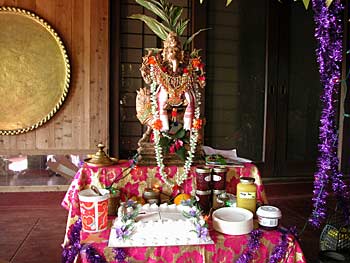 During the festival, a shrine is created in the main living room of the home and decorated in the spirit of this festive occasion. At the center of the shrine is an elaborate murti (statue) of Lord Pancha Ganapati that is decorated with numerous ornaments and garments. Each morning during the festival, fruits and sweets are presented to Ganesha. Every morning the children of the house add a new color to the statue, each with its own significance. On the first day, the color yellow is added to the statue, which signifies love and harmony within the family. Family members sit together, seek to repair strained relationships, offer one another amends and forgiveness, and relate the good qualities the each possesses. On the second day, blue is added to the statue, which signifies the relationship families have with their neighbors. On
During the festival, a shrine is created in the main living room of the home and decorated in the spirit of this festive occasion. At the center of the shrine is an elaborate murti (statue) of Lord Pancha Ganapati that is decorated with numerous ornaments and garments. Each morning during the festival, fruits and sweets are presented to Ganesha. Every morning the children of the house add a new color to the statue, each with its own significance. On the first day, the color yellow is added to the statue, which signifies love and harmony within the family. Family members sit together, seek to repair strained relationships, offer one another amends and forgiveness, and relate the good qualities the each possesses. On the second day, blue is added to the statue, which signifies the relationship families have with their neighbors. On
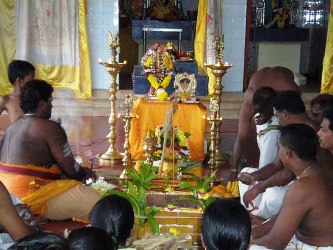 this day, families present gifts and food to their neighbors as a sign of love and respect; apologies and made and forgiveness sought for misunderstandings that may have occurred. On the third day, red is added, representing the love and respect individuals have with their business associates. Gifts are given to employers, employees, customers, and business partners; debts and disputes are settled. On the fourth day, green is added to the statue, representing the art and music the family enjoys. Gifts are again exchanged. Gifts from the previous four days remain unopened and are placed in front of the statue. On the fifth day, the large number of gifts in front of the statue symbolize the amount of love that each individual receives and Ganesh’s grace. On the fifth and final day, orange is added to the statue and represents the combined love from the first three days.
this day, families present gifts and food to their neighbors as a sign of love and respect; apologies and made and forgiveness sought for misunderstandings that may have occurred. On the third day, red is added, representing the love and respect individuals have with their business associates. Gifts are given to employers, employees, customers, and business partners; debts and disputes are settled. On the fourth day, green is added to the statue, representing the art and music the family enjoys. Gifts are again exchanged. Gifts from the previous four days remain unopened and are placed in front of the statue. On the fifth day, the large number of gifts in front of the statue symbolize the amount of love that each individual receives and Ganesh’s grace. On the fifth and final day, orange is added to the statue and represents the combined love from the first three days.
Profile prepared by Josh Jolly
May, 2009

![]() (Dance celebration of Lohri)
(Dance celebration of Lohri)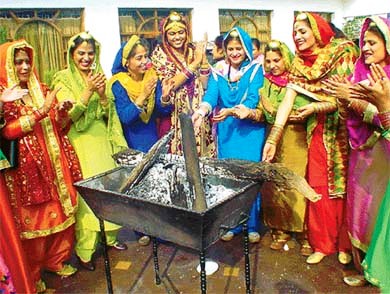 corresponds to December/January. In the Punjab region, wheat is the main crop, and between planting and harvesting the wheat, there is a major celebration. It is widely regarded as the Indian equivalent of Thanksgiving. Typically there is a massive bonfire around which locals will gather to dance, tell stories and enjoy a feast. Dulla Bhatti is a central figure in Lohri songs of celebration. He was a Muslim version of Robin Hood who would steal from the rich and give to those less fortunate, save girls from being sold into slavery, and pay for these same girls’
corresponds to December/January. In the Punjab region, wheat is the main crop, and between planting and harvesting the wheat, there is a major celebration. It is widely regarded as the Indian equivalent of Thanksgiving. Typically there is a massive bonfire around which locals will gather to dance, tell stories and enjoy a feast. Dulla Bhatti is a central figure in Lohri songs of celebration. He was a Muslim version of Robin Hood who would steal from the rich and give to those less fortunate, save girls from being sold into slavery, and pay for these same girls’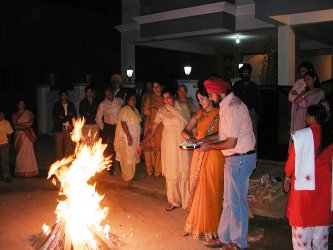

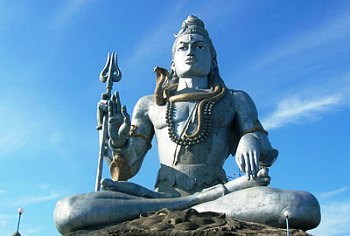 The festival is celebrated by Hindu’s, who fast for the whole day and attend temple and pray in honor of Lord Shiva. They offer bael leaves, along with food and sweets to Lord Shiva as a sign of love and respect (it is also seen as very auspicious), and maintain a vigil that lasts through the night. Hindus often draw three white lines on their foreheads with a paste, symbolizing spiritual knowledge, purity and penance as a sign of respect for Shiva as well. The purpose of the festival is to receive positive energy and karma for meditation.
The festival is celebrated by Hindu’s, who fast for the whole day and attend temple and pray in honor of Lord Shiva. They offer bael leaves, along with food and sweets to Lord Shiva as a sign of love and respect (it is also seen as very auspicious), and maintain a vigil that lasts through the night. Hindus often draw three white lines on their foreheads with a paste, symbolizing spiritual knowledge, purity and penance as a sign of respect for Shiva as well. The purpose of the festival is to receive positive energy and karma for meditation.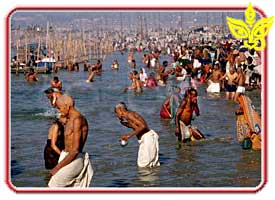 and is celebrated at the end of the Winter Solstice. This festival is significant to Hindus because it serves as a transition between the six months of light (Rama, or Heaven) and the six months of darkness (Ravana, or Hell). Makar Sankranti also pays homage to Saraswati, the goddess of knowledge and art. On the day before Makar Sankranti, those celebrating the festival go through their homes and throw out everything which is old and has lost meaning, getting ready for the transition to a new season and new things. Families give gifts to friends and neighbors as a sign of love.
and is celebrated at the end of the Winter Solstice. This festival is significant to Hindus because it serves as a transition between the six months of light (Rama, or Heaven) and the six months of darkness (Ravana, or Hell). Makar Sankranti also pays homage to Saraswati, the goddess of knowledge and art. On the day before Makar Sankranti, those celebrating the festival go through their homes and throw out everything which is old and has lost meaning, getting ready for the transition to a new season and new things. Families give gifts to friends and neighbors as a sign of love. During the festival, a shrine is created in the main living room of the home and decorated in the spirit of this festive occasion. At the center of the shrine is an elaborate murti (statue) of Lord Pancha Ganapati that is decorated with numerous ornaments and garments. Each morning during the festival, fruits and sweets are presented to Ganesha. Every morning the children of the house add a new color to the statue, each with its own significance. On the first day, the color yellow is added to the statue, which signifies love and harmony within the family. Family members sit together, seek to repair strained relationships, offer one another amends and forgiveness, and relate the good qualities the each possesses. On the second day, blue is added to the statue, which signifies the relationship families have with their neighbors. On
During the festival, a shrine is created in the main living room of the home and decorated in the spirit of this festive occasion. At the center of the shrine is an elaborate murti (statue) of Lord Pancha Ganapati that is decorated with numerous ornaments and garments. Each morning during the festival, fruits and sweets are presented to Ganesha. Every morning the children of the house add a new color to the statue, each with its own significance. On the first day, the color yellow is added to the statue, which signifies love and harmony within the family. Family members sit together, seek to repair strained relationships, offer one another amends and forgiveness, and relate the good qualities the each possesses. On the second day, blue is added to the statue, which signifies the relationship families have with their neighbors. On this day, families present gifts and food to their neighbors as a sign of love and respect; apologies and made and forgiveness sought for misunderstandings that may have occurred. On the third day, red is added, representing the love and respect individuals have with their business associates. Gifts are given to employers, employees, customers, and business partners; debts and disputes are settled. On the fourth day, green is added to the statue, representing the art and music the family enjoys. Gifts are again exchanged. Gifts from the previous four days remain unopened and are placed in front of the statue. On the fifth day, the large number of gifts in front of the statue symbolize the amount of love that each individual receives and Ganesh’s grace. On the fifth and final day, orange is added to the statue and represents the combined love from the first three days.
this day, families present gifts and food to their neighbors as a sign of love and respect; apologies and made and forgiveness sought for misunderstandings that may have occurred. On the third day, red is added, representing the love and respect individuals have with their business associates. Gifts are given to employers, employees, customers, and business partners; debts and disputes are settled. On the fourth day, green is added to the statue, representing the art and music the family enjoys. Gifts are again exchanged. Gifts from the previous four days remain unopened and are placed in front of the statue. On the fifth day, the large number of gifts in front of the statue symbolize the amount of love that each individual receives and Ganesh’s grace. On the fifth and final day, orange is added to the statue and represents the combined love from the first three days.